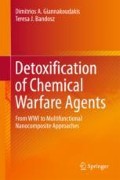Abstract
The opening act of the toxic gases deployment took place at the early months of WWI, when the French army fired tear gas grenades (filled with ethyl bromoacetate) against German soldiers (August 1914) [1].
Access this chapter
Tax calculation will be finalised at checkout
Purchases are for personal use only
References
M. Duffy, Weapons of War—Poison Gas (2009). http://www.firstworldwar.com
E.A. Croddy, J.J. Wirtz, Mass Weapons of Mass Destruction, 1st edn. (ABC-Clio, 2004)
D. Stoltzenberg, F. Haberm, Chemist, Nobel Laureate, German, Jew: A Biography, 1st edn. (Chemical Heritage Foundation, 2005)
J.J.Wirtz, E.A. Croddy, Weapons of Mass Destruction: An Encyclopedia of Worldwide Policy, Technology, and History, 1st edn. (2004)
J. Simon, World War I Gas Warfare Tactics and Equipment, vol 13 (Osprey Publishing, 2008)
R. Black, Development, historical use and properties of chemical warfare agents. Chem. Warf. Toxicol. Fundam. Asp. R. Soc. Chem. 1 (2016). https://doi.org/10.1039/9781849739696-00001
J. Davy, On a gaseous compound of carbonic oxide and chlorine. Philos. Trans. R. Soc. Lond. 102, 144–151 (1812). https://doi.org/10.1098/rstl.1812.0008
M. Vargic, (2013). www.historyrundown.com
M. Gunther, (2015). chemistryworld.com
H.B. Kagan, Victor Grignard and Paul Sabatier: two showcase laureates of the nobel prize for chemistry. Angew. Chem. Int. Ed. Engl. 7376–7382 (2012). https://doi.org/10.1002/anie.201201849
J. Patocka, K. Kuca, Irritant compounds : military respiratory irritants. Part I. Lacrimators 84, 128–139 (2015)
T. Marrs, R. Maynard, F. Sidell, Chemical Warfare Agents: Toxicology and Treatment, 2nd edn. (Wiley, West Sussex, England, 2007)
L. Szinicz, History of chemical and biological warfare agents. Toxicology 214, 167–181 (2005). https://doi.org/10.1016/j.tox.2005.06.011
D.A. Giannakoudakis, Synthesis of Complex/Multifunctional Metal (Hydr) oxide/Graphite Oxide/AuNPs or AgNPs Adsorbents and Analysis of their Interactions with Chemical Warfare Agents. Thesis, CUNY Acad. Work 2017
C.H. Heller, Chemical Warfare in World War I: The American Experience, 1917-1918 (Leavenworth Pap, 1984), p. 109
K. Kim, O.G. Tsay, D.A. Atwood, D.G. Churchill, Destruction and detection of chemical warfare agents. Chem. Rev. (Washington, DC, United States) 111, 5345–5403 (2011). https://doi.org/10.1021/cr100193y
M. Duffy, (n.d.). firstworldwar.com
D. Charles, Master Mind: The Rise and Fall of Fritz Haber, The Nobel Laureate who Launched the Age of Chemical Warfare, 1st edn. (2005)
100 years of chemical weapons. Chem. Eng. News. (2015). http://chemicalweapons.cenmag.org
J.P. Smol; E.F. Stoermer (eds.), The Diatoms: Applications for the Environmental and Earth Sciences, 2nd edn. (Cambridge University Press, 2010)
L.E. Antonides, DIATOMITE, Sophia, pp. 1–7 (1998)
T.J. Bandosz, Activated Carbon Surfaces in Environmental Remediation (Elsevier, 2006)
D. Trauner, Richard Willstätter and the 1915 nobel prize in chemistry. Angew. Chem. Int. Ed. Engl. 54, 11910–11916 (2015). https://doi.org/10.1002/anie.201505507
T.M. Maguire, B. Baker, Em38 British Military Respirators and Anti-Gas Equipment of the Two World Wars, 1st edn. (The Crowood Press, 2015)
French Tissot Apparatus (AKA Tissot Large Box Respirator)|Gas Mask and Respirator Wiki|Fandom powered by Wikia, (n.d.)
Itineraries of WWI-Travelling in history (2010). http://www.itinerarigrandeguerra.com/code/43726/The-attack-with-phosgene-on-Mount-San-Michele
N. Thomas, D. Babc, Armies in the Balkans 1914–18, 1st edn. (Osprey Publishing, 2001)
A.N. Nesmeyanov, A.V. Tophiev, B.A. Kazansky, N.I. Shuikin, To the memory of academician Nikolai Dmitrievich Zelinsky. Bull. Acad. Sci. USSR Div. Chem. Sci. 2, 683–690 (1954). https://doi.org/10.1007/BF01178843
T.I. Faith, Behind the Gas Mask: The U.S. Chemical Warfare Service in War and Peace (University of Illinois Press, 2014)
Author information
Authors and Affiliations
Corresponding authors
Rights and permissions
Copyright information
© 2018 Springer International Publishing AG
About this chapter
Cite this chapter
Giannakoudakis, D.A., Bandosz, T.J. (2018). World War I: Militarization of Chemistry. In: Detoxification of Chemical Warfare Agents . Springer, Cham. https://doi.org/10.1007/978-3-319-70760-0_2
Download citation
DOI: https://doi.org/10.1007/978-3-319-70760-0_2
Published:
Publisher Name: Springer, Cham
Print ISBN: 978-3-319-70759-4
Online ISBN: 978-3-319-70760-0
eBook Packages: Chemistry and Materials ScienceChemistry and Material Science (R0)

